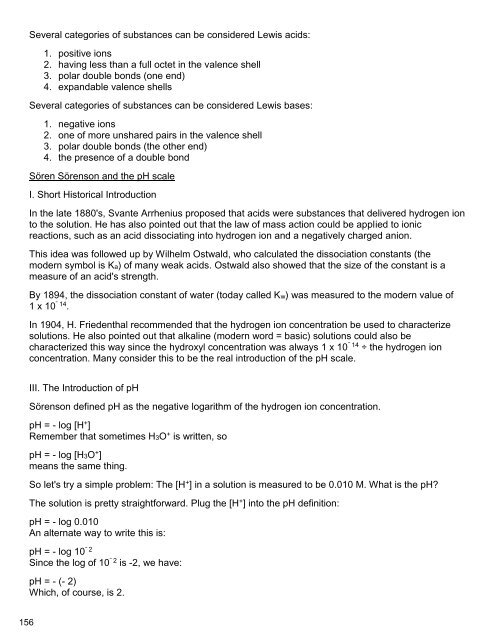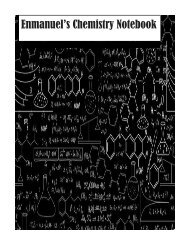Create successful ePaper yourself
Turn your PDF publications into a flip-book with our unique Google optimized e-Paper software.
Several categories of substances can be considered Lewis acids:<br />
1. positive ions<br />
2. having less than a full octet in the valence shell<br />
3. polar double bonds (one end)<br />
4. expandable valence shells<br />
Several categories of substances can be considered Lewis bases:<br />
1. negative ions<br />
2. one of more unshared pairs in the valence shell<br />
3. polar double bonds (the other end)<br />
4. the presence of a double bond<br />
Sören Sörenson and the pH scale<br />
I. Short Historical Introduction<br />
In the late 1880's, Svante Arrhenius proposed that acids were substances that delivered hydrogen ion<br />
to the solution. He has also pointed out that the law of mass action could be applied to ionic<br />
reactions, such as an acid dissociating into hydrogen ion and a negatively charged anion.<br />
This idea was followed up by Wilhelm Ostwald, who calculated the dissociation constants (the<br />
modern symbol is Ka) of many weak acids. Ostwald also showed that the size of the constant is a<br />
measure of an acid's strength.<br />
By 1894, the dissociation constant of water (today called Kw) was measured to the modern value of<br />
1 x 10¯14 .<br />
In 1904, H. Friedenthal recommended that the hydrogen ion concentration be used to characterize<br />
solutions. He also pointed out that alkaline (modern word = basic) solutions could also be<br />
characterized this way since the hydroxyl concentration was always 1 x 10¯14 ÷ the hydrogen ion<br />
concentration. Many consider this to be the real introduction of the pH scale.<br />
III. The Introduction of pH<br />
Sörenson defined pH as the negative logarithm of the hydrogen ion concentration.<br />
pH = - log [H + ]<br />
Remember that sometimes H3O + is written, so<br />
pH = - log [H3O + ]<br />
means the same thing.<br />
So let's try a simple problem: The [H + ] in a solution is measured to be 0.010 M. What is the pH?<br />
The solution is pretty straightforward. Plug the [H + ] into the pH definition:<br />
pH = - log 0.010<br />
An alternate way to write this is:<br />
pH = - log 10¯2<br />
Since the log of 10¯2 is -2, we have:<br />
pH = - (- 2)<br />
Which, of course, is 2.




